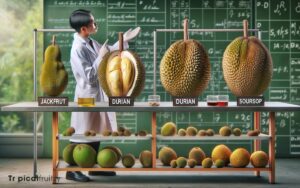How Long for Durian Tree to Bear Fruit? Explained!
Durian trees typically take about 5 to 10 years to bear fruit when grown from seed. However, trees that are grafted can bear fruit in as little as 4 to 5 years.
Durian, known often as the “king of fruits” in Southeast Asia, is notorious for its strong aroma and distinctive taste. The time it takes for a durian tree to bear fruit can vary based on several factors:
For example, a durian tree grown in optimal conditions in Malaysia may bear fruit faster than one in a less ideal climate.
A durian tree’s journey from seed to fruit is a test of patience, generally spanning 5 to 10 years, influenced by care, climate, and cultivation techniques.
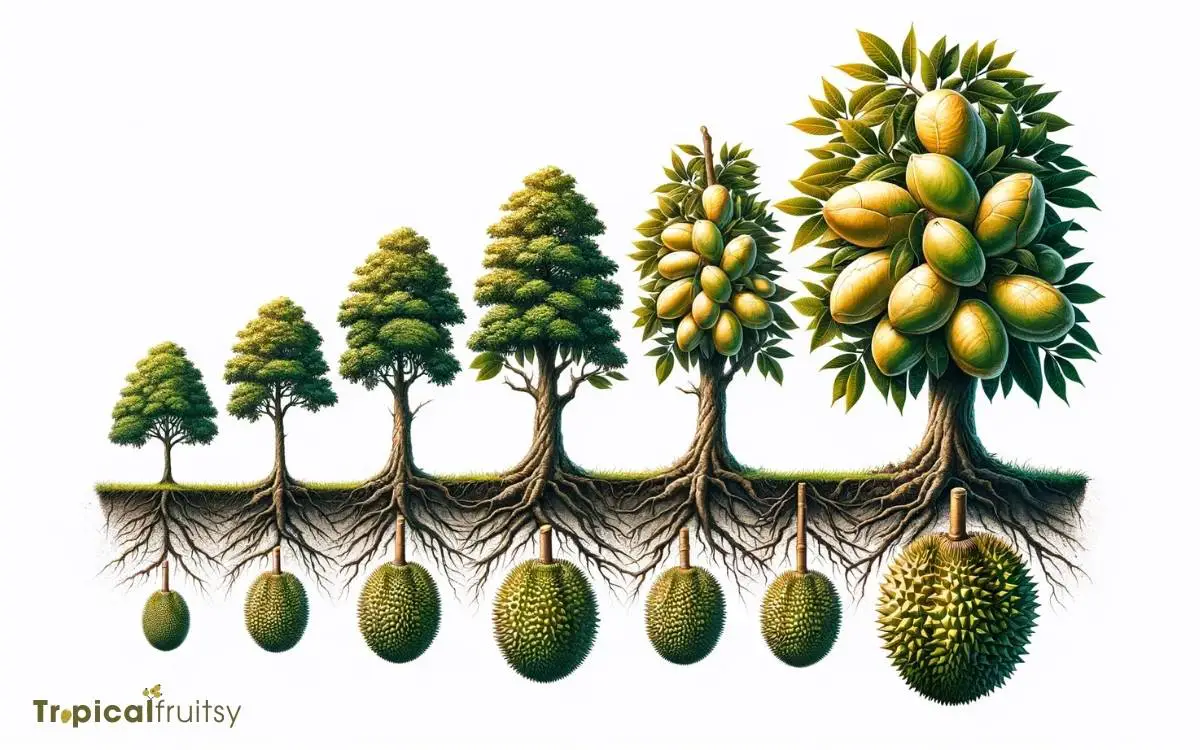
Key Takeaway
Durian Tree Fruit Bearing Timeline
| Factor | Description | Influence on Fruiting Time |
|---|---|---|
| Variety | Some durian varieties mature faster than others. | Can reduce or extend time |
| Climate | Warm, humid tropical climates are ideal for durian growth. | Can accelerate growth |
| Soil Fertility | Rich, well-drained soil contributes to healthier trees and quicker maturation. | Positively impacts timing |
| Tree Age | Generally, durian trees start to bear fruit 4-7 years after planting. | Primary indicator |
| Care & Cultivation | Includes irrigation, fertilization, and pruning. | Can significantly affect |
| Grafting | Grafted trees can bear fruit earlier than seed-grown trees. | Reduces time to fruiting |
Durian Tree Basics
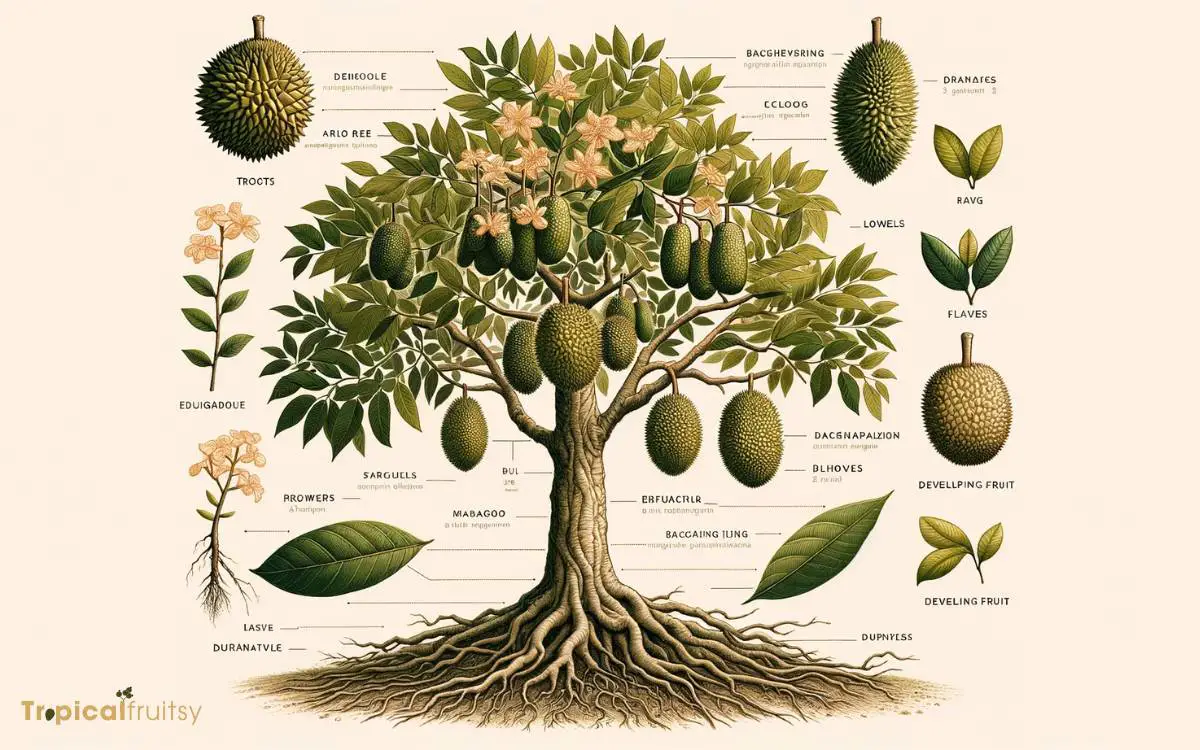
The durian tree, known scientifically as Durio zibethinus, typically requires a period of four to five years after planting before it begins to produce fruit.
This tropical species, indigenous to Southeast Asia, is characterized by its large size, potentially reaching up to 50 meters in optimal conditions, though typically averaging around 25 meters in cultivation.
It possesses evergreen, alternate leaves, and bears flowers with a distinctive odor, which later develop into the notably large and spiky fruit known for its pungent aroma.
Proper soil conditions, adequate water supply, and appropriate climatic factors are crucial for the tree’s development and eventual fruit production. Understanding these factors is key to successful cultivation.
Growth Milestones Explained
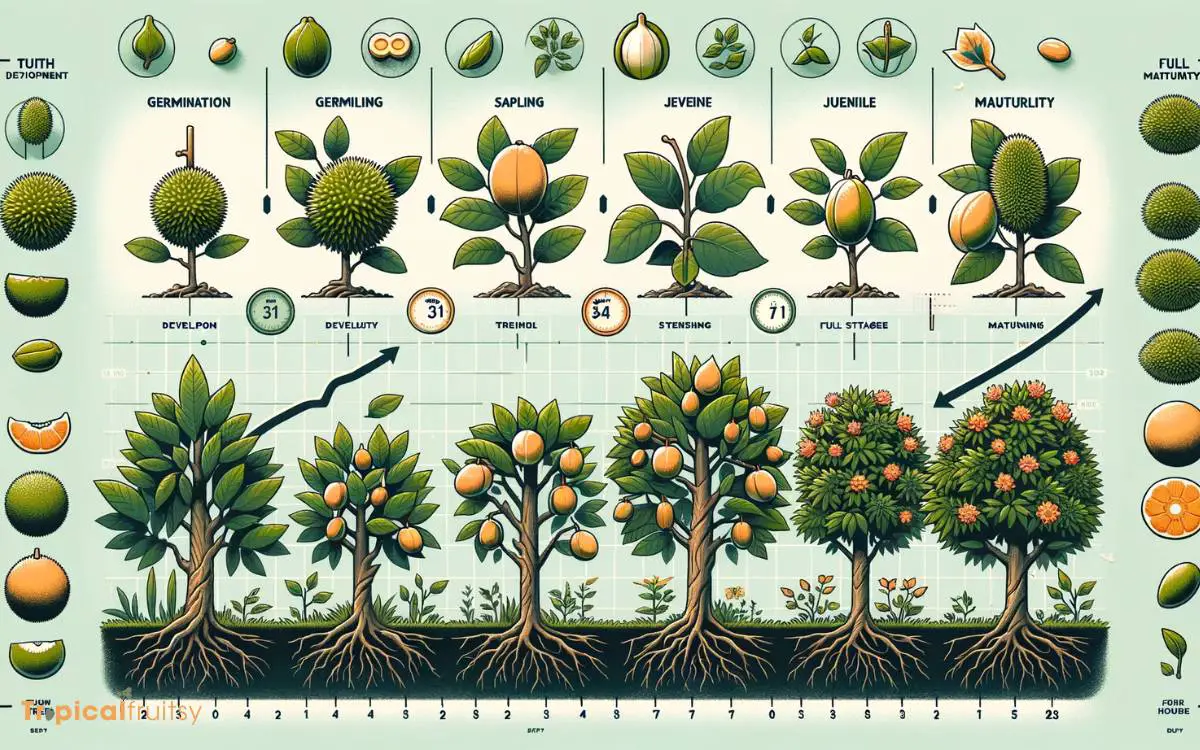
Understanding the growth milestones of a durian tree is essential, as it progresses through several stages before bearing its first fruits.
Initially, the durian sapling focuses on establishing a robust root system and vegetative growth, which typically spans the first 1 to 2 years.
Following this, the tree enters a juvenile phase, characterized by the expansion of the canopy and stem thickening, a critical period that can last up to 3 to 5 years.
During these formative years, proper care in terms of soil fertility management, irrigation, and pest control is paramount.
As the tree matures, floral induction begins, leading to the development of flower clusters. Successful pollination will then herald the onset of fruit setting and development.
These processes intricately set the stage for the next topic of discussion: the varietal impact on maturation.
Varietal Impact on Maturation
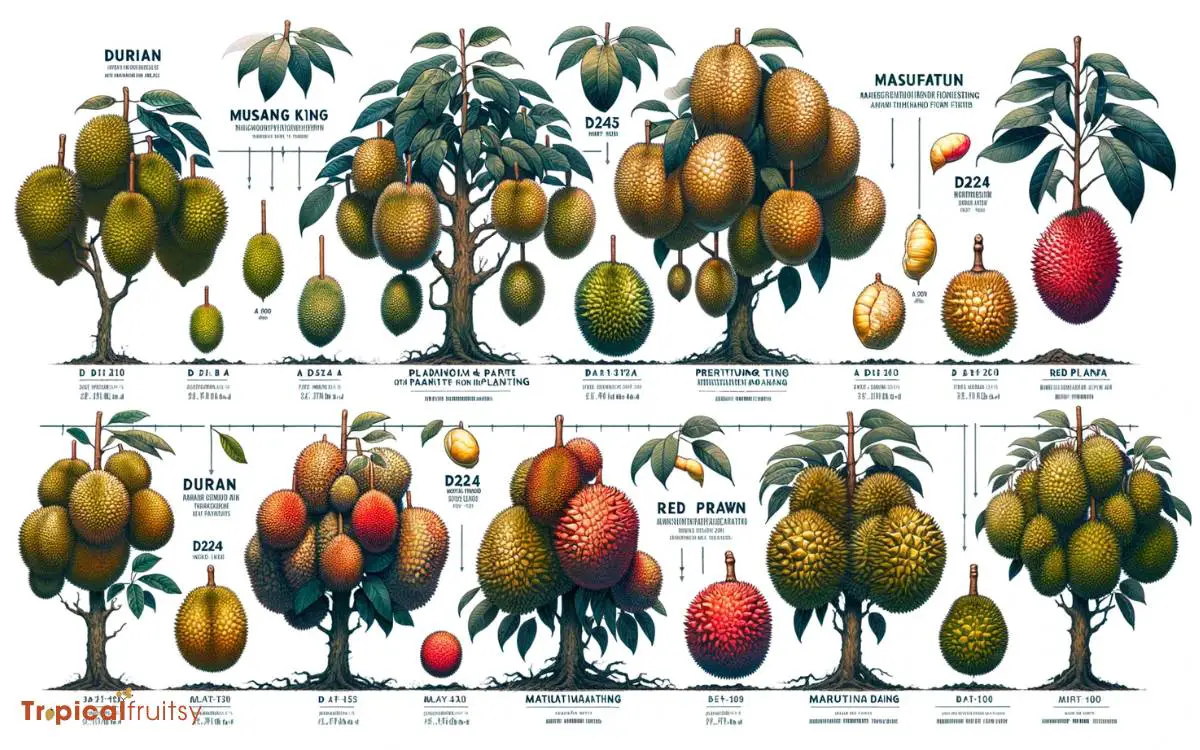
Different durian varieties exhibit varying maturation times, influencing the duration until they first bear fruit. The genetic makeup of each cultivar dictates its growth rate, fruit development period, and overall yield.
Understanding these distinctions is essential for cultivators to manage expectations and optimize production timelines.
Dwarf Varieties:
- Faster maturation
- Earlier fruiting, often within 4-5 years
- Suitable for smaller spaces
Traditional Varieties:
- Longer maturation periods
- Can take 7-10 years to bear fruit
- Potential for larger yields
Hybrid Varieties:
- Engineered for specific traits
- Varying maturation timelines
- May offer disease resistance or improved fruit quality
Climatic Influence on Fruiting
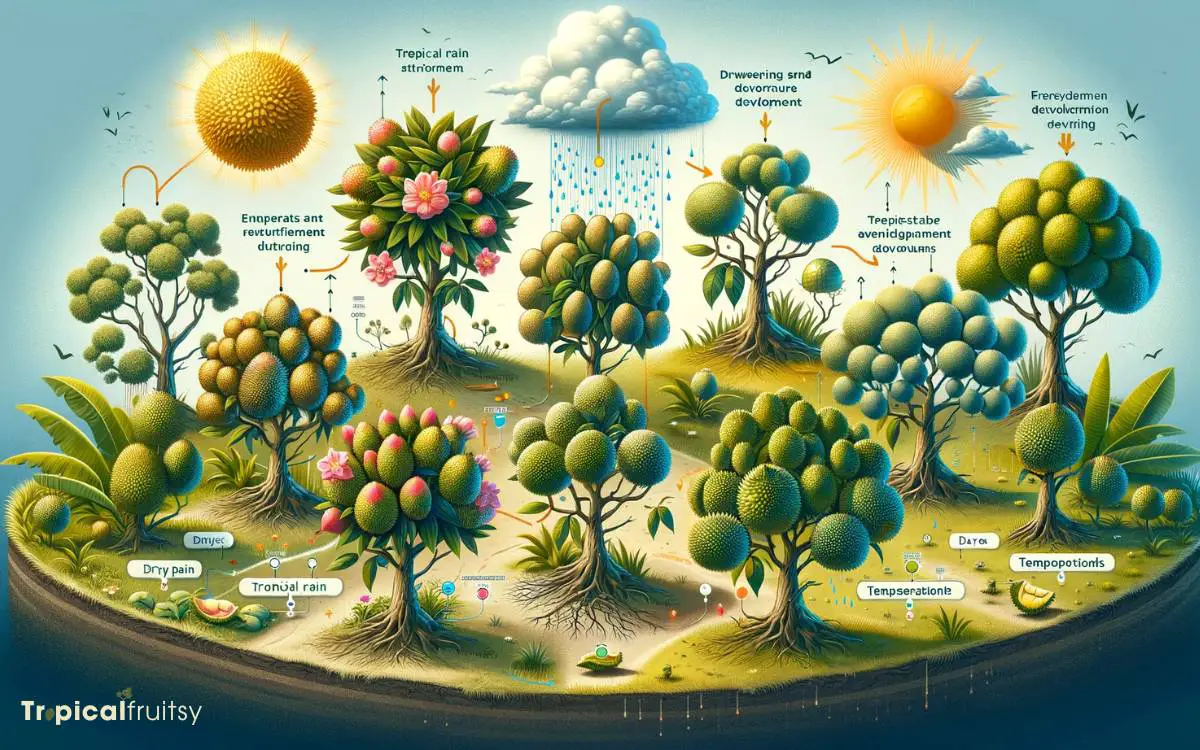
The climatic conditions under which Durian trees are cultivated play a pivotal role in their fruiting timelines and overall yield.
Temperature ranges between 24°C to 30°C are considered ideal for durian cultivation, with deviations from this range potentially delaying fruit development or reducing fruit quality.
Moreover, consistent and adequate rainfall, coupled with the recognition of distinct seasonal growth cycles, is crucial for synchronizing flowering and ensuring successful pollination and fruit set.
Optimal Growing Temperatures
Durian trees thrive and bear fruit most effectively in environments where the average temperature ranges between 22°C and 30°C (72°F to 86°F).
This optimum temperature range is crucial for metabolic processes such as enzymatic activities that drive growth and fruit development, as well as photosynthesis efficiency, vital for energy production.
In addition, the temperature plays a significant role in flower and fruit set. It is responsible for the induction of flowering, which is a temperature-sensitive phase. The temperature also affects fruit set and retention, ensuring a higher yield.
Moreover, temperature plays a role in stress reduction for durian trees. It helps in minimizing heat stress, which can lead to flower and fruit drop. It also reduces the risk of cold-induced dormancy or damage.
While temperature is a pivotal factor, it works synergistically with other environmental conditions.
As we consider the temperature’s influence, it is equally important to understand how rainfall patterns impact durian fruiting cycles.
Rainfall Patterns Impact
Examining rainfall patterns is essential in understanding their direct effects on the fruiting cycles of durian trees.
Durian trees require ample water for growth and fruit development, with an optimal annual rainfall range of 1500 to 3000 millimeters, distributed evenly throughout the year.
However, a period of dryness is critical before the onset of flowering. Excessive rainfall during this period can lead to flower drop and reduced fruit set, impacting yield.
Conversely, insufficient rainfall can lead to water stress, adversely affecting the tree’s physiological processes, including the ability to produce and sustain fruit.
Adequate water management practices must be employed to mitigate these climatic challenges. Understanding these intricacies paves the way to the subsequent discussion on ‘seasonal growth cycles’.
Seasonal Growth Cycles
Seasonally, durian trees enter distinct growth phases influenced heavily by climatic conditions, with each phase playing a pivotal role in the tree’s maturation and eventual fruit production.
These cycles can be delineated as follows:
Vegetative Growth:
- Initiated by the onset of the rainy season.
- Vital for providing the structural foundation for fruit support.
Flowering:
- Triggered by dry spells following vegetative growth.
- Critical for pollination and subsequent fruit set.
Fruiting:
- Requires a balance of rainfall and dry periods for optimal development.
- The culmination of the cycle, leading to mature durian fruits ready for harvest.
Understanding these cycles is essential for effective care and cultivation practices, which will be expounded upon in the following section.
Care and Cultivation Practices
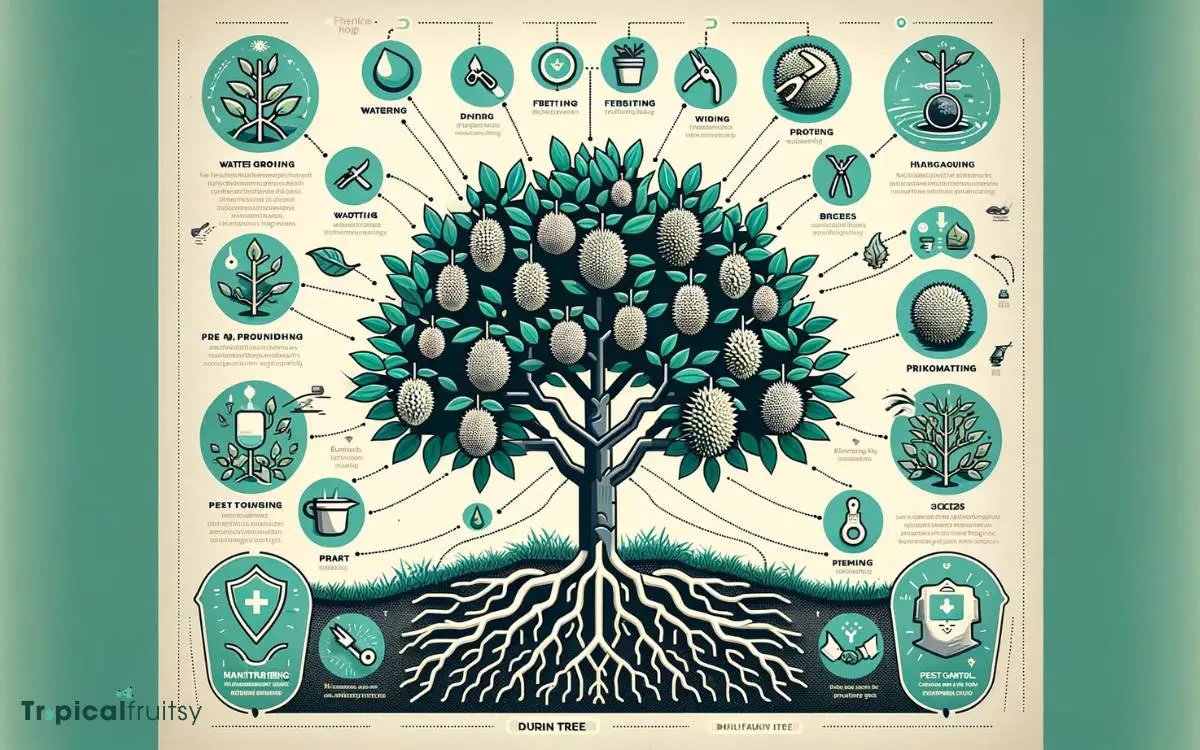
To ensure the successful fruiting of durian trees, adherence to specific care and cultivation practices is paramount.
The creation of optimal soil conditions involves maintaining a balance of essential nutrients and proper pH levels, which are critical for durian tree health and productivity.
Regular watering patterns must be established to match the tree’s developmental stage and environmental requirements, while strategic pruning techniques are employed to facilitate sunlight penetration and air circulation, crucial for fruit set and quality.
Optimal Soil Conditions
For a durian tree to successfully bear fruit, it is imperative that the soil conditions are rich, well-drained, and fertile, with a pH ranging from 6 to 7.
To optimize soil conditions for durian cultivation, consider the following technical aspects:
Soil Composition:
- High organic matter content to enhance soil fertility
- Adequate sand and clay balance to facilitate proper drainage while retaining nutrients
Soil pH:
- Slightly acidic to neutral pH (6-7) is crucial for optimal nutrient uptake
- Regular soil testing to monitor pH levels and adjust accordingly
Nutrient Management:
- Balanced application of nitrogen, phosphorus, and potassium (NPK)
- Incorporation of micronutrients such as zinc and boron to prevent deficiencies
These soil management practices are essential for the durian tree’s growth and fruiting potential.
Watering Frequency
While ensuring optimal soil conditions is crucial for the health of durian trees, consistent and appropriate watering is equally important to support their growth and fruit production cycle.
Durian trees, being native to tropical climates, require ample and regular hydration to thrive. The frequency of watering should align with the tree’s developmental stage and the ambient environmental conditions.
Young trees typically necessitate more frequent watering to establish their root systems—often twice a week. As trees mature, irrigation can be reduced, usually to once a week, depending on rainfall patterns.
Over-watering should be avoided to prevent root rot, a condition detrimental to the tree’s health. Proper drainage must be ensured to maintain the right moisture balance within the soil.
Monitoring soil moisture content is critical for optimal water management, ensuring trees receive adequate hydration to foster vigorous growth and fruitful yields.
Pruning Techniques
Employing strategic pruning techniques is essential for durian trees not only to maintain their structure and health but also to expedite the onset of fruit-bearing.
Pruning optimizes tree vitality and encourages the development of strong branches capable of supporting heavy fruit loads.
The following practices are paramount:
Formative Pruning:
- Establish a robust scaffold structure during the tree’s early years.
- Remove competing leaders to promote a single, dominant trunk.
- Thin out branches to ensure adequate light penetration and airflow.
Maintenance Pruning:
- Annually remove dead or diseased wood to prevent infection.
- Cut back overextended branches to balance the canopy and reduce breakage risk.
- Fruit Enhancement Pruning:
- Selectively thin fruit-bearing areas to boost fruit size and quality.
- Implement restorative cuts post-harvest to rejuvenate fruiting sites for subsequent seasons.
Harvesting Your First Durians

After a durian tree reaches maturity, typically between five to seven years after planting, you can anticipate the exhilarating moment of harvesting your first fruits.
The harvest season, which usually occurs twice a year, demands vigilant observation as durians do not all ripen simultaneously.
To ascertain ripeness, one must seek subtle changes in the fruit’s stem and husk coloration, as well as a distinctive, pungent aroma.
It is critical to note that durians spontaneously detach from the tree once fully mature, falling to the ground. Employing netting can prevent bruising upon impact.
The ideal harvesting technique involves daily monitoring and gentle collection of fruits that have naturally dropped during the preceding night, ensuring optimal flavor and texture for consumption or sale.
How Many Fruits Can a Durian Tree Bear
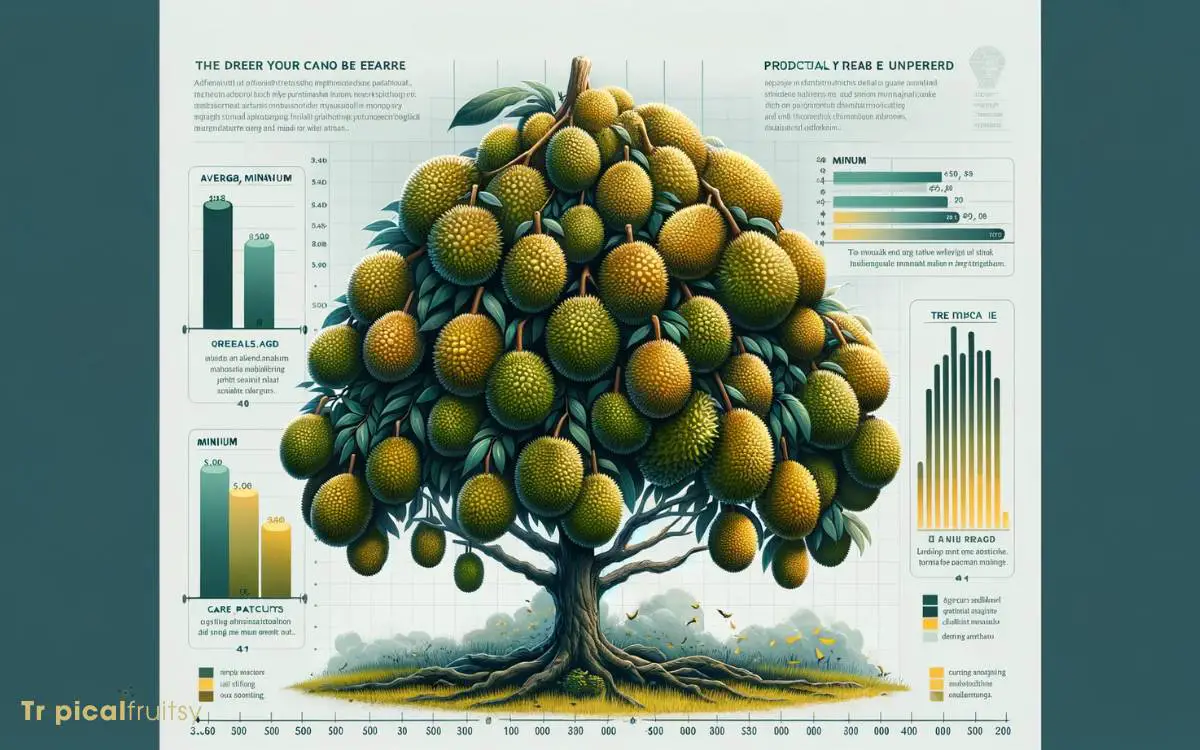
The number of fruits a durian tree can bear depends on various factors, including the tree’s age, health, and environmental conditions.
Typically, a mature and healthy durian tree can produce between 50 to 200 fruits in a single season. However, some exceptional trees may yield even more.
Here are some factors that can influence the fruit production of a durian tree:
- Age of the tree: Young durian trees typically produce fewer fruits than mature ones. It takes several years for a durian tree to reach full maturity and start bearing a substantial quantity of fruit.
- Health and nutrition: The health of the tree, along with proper nutrition and care, can significantly impact fruit production. Well-maintained trees tend to produce more fruit.
- Variety of durian: Different durian varieties may have varying levels of fruit production. Some varieties are known for being prolific fruit bearers, while others may produce fewer fruits but have other desirable qualities.
- Environmental conditions: Adequate sunlight, rainfall, and proper climate conditions are essential for optimal fruit production. Durian trees thrive in tropical climates with consistent warmth and moisture.
- Pollination: Successful pollination is critical for fruit formation. In some cases, durian trees may require the assistance of insects or manual pollination to ensure a good fruit set.
- Pruning and maintenance: Proper pruning and care can promote fruit production by allowing more sunlight to reach the tree’s branches and reducing disease or pest infestations.
It’s essential to note that durian trees typically have a fruiting season, and the number of fruits produced may vary from year to year.
Durian trees are known for their irregular fruiting patterns, so one year may yield a substantial harvest, while the next year may have fewer fruits.
Overall, with proper care and environmental conditions, a mature durian tree can produce a significant number of fruits, making it a valuable fruit tree for those who cultivate it.
Conclusion
Durian trees, with their complex growth milestones and diverse varietal characteristics, require meticulous care and optimal climatic conditions to yield their distinctive fruits.
Through rigorous cultivation practices, these tropical arboreal giants can bear their coveted bounty.
The convergence of science, patience, and horticultural expertise is essential in guiding these majestic trees from their nascent stages to the moment of triumphant harvest.


